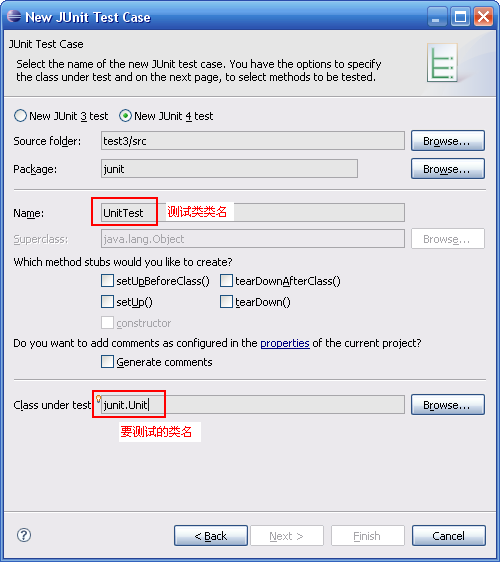Junit4,与3.x有所区别
1. 测试类不需要extends TestCase,代之以annotation,即测试类(不需要extends TestCase)的方法只要有@Test就可以了
2. 测试方法命名不需要一定要以test开头
 package
junit;
package
junit;

 public
class
Unit
{
public
class
Unit
{
 private int data;
private int data;

 public Unit(int data){
public Unit(int data){
 this.data = data;
this.data = data;
 }
}
 public boolean test(){
public boolean test(){
 return true;
return true;
 }
}

 public boolean equals(Object o){
public boolean equals(Object o){
 if(o instanceof Unit){
if(o instanceof Unit){
 return ((Unit)o).data == data;
return ((Unit)o).data == data;
 }
}

 return false;
return false;
 }
}

 public void exception(){
public void exception(){
 if (this.data==0)
if (this.data==0)
 throw new IndexOutOfBoundsException("exception in Unit");
throw new IndexOutOfBoundsException("exception in Unit");
 }
}
 }
}

可以用eclipse自动生成测试类,选中要测试的类,然后new -junit test case

测试类:
 package
junit;
package
junit;

 import
org.junit.
*
;
import
org.junit.
*
;

 public
class
UnitTest
{
public
class
UnitTest
{

 private Unit unit1 = new Unit(1);
private Unit unit1 = new Unit(1);
 private Unit unit2 = new Unit(2);
private Unit unit2 = new Unit(2);

 @BeforeClass
@BeforeClass
 public static void setUpBeforeClass() throws Exception {
public static void setUpBeforeClass() throws Exception {
 System.out.println("setUpBeforeClass");
System.out.println("setUpBeforeClass");
 }
}

 @AfterClass
@AfterClass
 public static void tearDownAfterClass() throws Exception {
public static void tearDownAfterClass() throws Exception {
 System.out.println("tearDownAfterClass");
System.out.println("tearDownAfterClass");
 }
}

 @Before
@Before
 public void setUp() throws Exception {
public void setUp() throws Exception {
 System.out.println("setUp");
System.out.println("setUp");
 }
}

 @After
@After
 public void tearDown() throws Exception {
public void tearDown() throws Exception {
 System.out.println("tearDown");
System.out.println("tearDown");
 }
}

 @Test
@Test
 public void notestTest() { // 方法名不以test开头
public void notestTest() { // 方法名不以test开头
 //fail("Not yet implemented");
//fail("Not yet implemented");
 Assert.assertTrue(unit1.test());
Assert.assertTrue(unit1.test());
 }
}

 @Test
@Test
 public void testEqualsObject() {
public void testEqualsObject() {
 //fail("Not yet implemented");
//fail("Not yet implemented");
 Assert.assertEquals(unit1, new Unit(1));
Assert.assertEquals(unit1, new Unit(1));
 Assert.assertEquals(unit1, unit2);
Assert.assertEquals(unit1, unit2);
 }
}

 @Test(expected = IndexOutOfBoundsException.class)
@Test(expected = IndexOutOfBoundsException.class)
 public void testException() {
public void testException() {
 //fail("Not yet implemented");
//fail("Not yet implemented");
 new Unit(0).exception();
new Unit(0).exception();
 }
}
 }
}

测试结果如下

为了进行TestSuit,再增加一个testcase
 package
junit;
package
junit;

 public
class
Unit2
{
public
class
Unit2
{
 public boolean test(){
public boolean test(){
 return true;
return true;
 }
}
 }
}

 package
junit;
package
junit;


 import
org.junit.Test;
import
org.junit.Test;

 public
class
Unit2Test
{
public
class
Unit2Test
{

 @Test
@Test
 public void testTest() {
public void testTest() {
 //fail("Not yet implemented");
//fail("Not yet implemented");
 org.junit.Assert.assertTrue(new Unit2().test());
org.junit.Assert.assertTrue(new Unit2().test());
 }
}

 }
}

==================================================================================
增加一个TestSuit(使用ecilpse的new -junit Test Suit只能找到3.x风格的extends TestCase的测试类,不知为何)
 package
junit;
package
junit;

 import
org.junit.runner.RunWith;
import
org.junit.runner.RunWith;
 import
org.junit.runners.Suite;
import
org.junit.runners.Suite;
 import
org.junit.runners.Suite.SuiteClasses;
import
org.junit.runners.Suite.SuiteClasses;

 @RunWith(Suite.
class
)
@RunWith(Suite.
class
)
 @SuiteClasses(
{ UnitTest.class, Unit2Test.class }
)
@SuiteClasses(
{ UnitTest.class, Unit2Test.class }
)
 public
class
Suit
{
public
class
Suit
{
 }
}

TestSuit测试结果

以下是控制台输出信息,跟测试类的各种annotation有关

=====================================================================================
1. 测试类不需要extends TestCase,代之以annotation,即测试类(不需要extends TestCase)的方法只要有@Test就可以了
2. 测试方法命名不需要一定要以test开头
 package
junit;
package
junit;
 public
class
Unit
{
public
class
Unit
{ private int data;
private int data;
 public Unit(int data){
public Unit(int data){ this.data = data;
this.data = data; }
} public boolean test(){
public boolean test(){ return true;
return true; }
}
 public boolean equals(Object o){
public boolean equals(Object o){ if(o instanceof Unit){
if(o instanceof Unit){ return ((Unit)o).data == data;
return ((Unit)o).data == data;  }
}
 return false;
return false; }
}
 public void exception(){
public void exception(){ if (this.data==0)
if (this.data==0) throw new IndexOutOfBoundsException("exception in Unit");
throw new IndexOutOfBoundsException("exception in Unit"); }
} }
}

可以用eclipse自动生成测试类,选中要测试的类,然后new -junit test case

测试类:
 package
junit;
package
junit;
 import
org.junit.
*
;
import
org.junit.
*
;
 public
class
UnitTest
{
public
class
UnitTest
{
 private Unit unit1 = new Unit(1);
private Unit unit1 = new Unit(1); private Unit unit2 = new Unit(2);
private Unit unit2 = new Unit(2); 
 @BeforeClass
@BeforeClass public static void setUpBeforeClass() throws Exception {
public static void setUpBeforeClass() throws Exception { System.out.println("setUpBeforeClass");
System.out.println("setUpBeforeClass"); }
}
 @AfterClass
@AfterClass public static void tearDownAfterClass() throws Exception {
public static void tearDownAfterClass() throws Exception { System.out.println("tearDownAfterClass");
System.out.println("tearDownAfterClass"); }
}
 @Before
@Before public void setUp() throws Exception {
public void setUp() throws Exception { System.out.println("setUp");
System.out.println("setUp"); }
}
 @After
@After public void tearDown() throws Exception {
public void tearDown() throws Exception { System.out.println("tearDown");
System.out.println("tearDown"); }
}
 @Test
@Test public void notestTest() { // 方法名不以test开头
public void notestTest() { // 方法名不以test开头 //fail("Not yet implemented");
//fail("Not yet implemented"); Assert.assertTrue(unit1.test());
Assert.assertTrue(unit1.test()); }
}
 @Test
@Test public void testEqualsObject() {
public void testEqualsObject() { //fail("Not yet implemented");
//fail("Not yet implemented"); Assert.assertEquals(unit1, new Unit(1));
Assert.assertEquals(unit1, new Unit(1)); Assert.assertEquals(unit1, unit2);
Assert.assertEquals(unit1, unit2); }
}
 @Test(expected = IndexOutOfBoundsException.class)
@Test(expected = IndexOutOfBoundsException.class) public void testException() {
public void testException() { //fail("Not yet implemented");
//fail("Not yet implemented"); new Unit(0).exception();
new Unit(0).exception(); }
} }
}

测试结果如下

为了进行TestSuit,再增加一个testcase
 package
junit;
package
junit;
 public
class
Unit2
{
public
class
Unit2
{ public boolean test(){
public boolean test(){ return true;
return true; }
} }
}

 package
junit;
package
junit;

 import
org.junit.Test;
import
org.junit.Test;
 public
class
Unit2Test
{
public
class
Unit2Test
{
 @Test
@Test public void testTest() {
public void testTest() { //fail("Not yet implemented");
//fail("Not yet implemented"); org.junit.Assert.assertTrue(new Unit2().test());
org.junit.Assert.assertTrue(new Unit2().test()); }
}
 }
}

==================================================================================
增加一个TestSuit(使用ecilpse的new -junit Test Suit只能找到3.x风格的extends TestCase的测试类,不知为何)
 package
junit;
package
junit;
 import
org.junit.runner.RunWith;
import
org.junit.runner.RunWith; import
org.junit.runners.Suite;
import
org.junit.runners.Suite; import
org.junit.runners.Suite.SuiteClasses;
import
org.junit.runners.Suite.SuiteClasses;
 @RunWith(Suite.
class
)
@RunWith(Suite.
class
) @SuiteClasses(
{ UnitTest.class, Unit2Test.class }
)
@SuiteClasses(
{ UnitTest.class, Unit2Test.class }
) public
class
Suit
{
public
class
Suit
{ }
}

TestSuit测试结果

以下是控制台输出信息,跟测试类的各种annotation有关

=====================================================================================


























 663
663

 被折叠的 条评论
为什么被折叠?
被折叠的 条评论
为什么被折叠?








